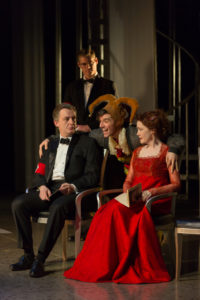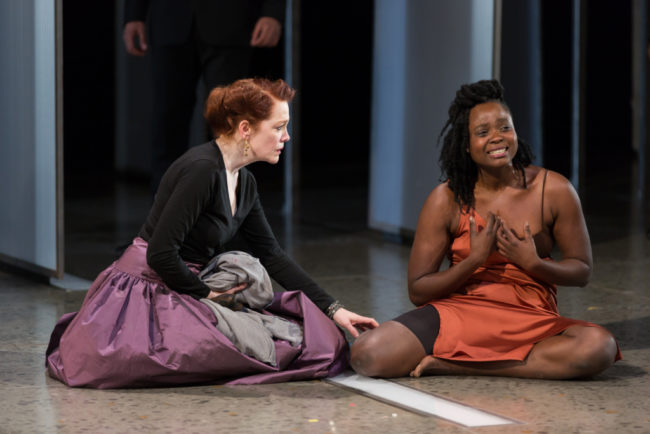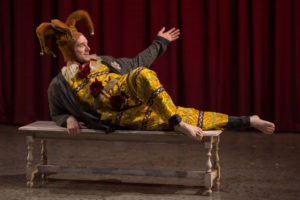Madness in great ones must not unwatched go. By that logic, theatergoers should be rushing out to Shakespeare Theater Company for Michael Kahn’s production of Hamlet starring Michael Urie as the mad Danish prince. Disturbingly dystopian, albeit conceptually undercooked, this production marks the end of an era as Michael Kahn, the show’s director and the company’s long-standing artistic director, makes it his final production before retiring. Not without impressive performances given by the featured player and others, the production generates a new and confusing look at Hamlet, attempting to present a strong parallel to a myriad of topics relevant to modern society.

The initial aesthetic frame-up is quite striking even if Kahn is unable to fully deliver his concept to fruition. Scenic Designer John Coyne has constructed a none-too-distantly futuristic dystopian outlay, which blends the notions of prison camps of the Third Reich and the “big-brother” surveillance of the Soviet Union into a prison-esque structure of scaffolding, cement, and walkways. This serves the show’s aesthetic well, even if the concept that motivates is oft left trailing behind the motion of the plot. Coyne partners up with Projection & Video Designer Patrick W. Lord to masterfully address the ghost of King Hamlet in a technologically advanced fashion. Arguably the scene where the guards first encounter the ghost— which does not start the play (a point of contention to be addressed momentarily)— is the best use of concept that Kahn has outlaid with Coyne and Lord’s design efforts.
One of the major dysfunctions of Kahn’s retooling of the production is how he shies away from the vision he’s created both in the aesthetic and in the framework. There are moments throughout the show that cry out for a stronger force of the implements that he’s used to recreate the way he sees Hamlet. The strongest example lies in the costumes, crafted by Costume Designer Jess Goldstein. Totalitarian and yet modern, Goldstein sets recognizable character types— the business man, the night-watch security guard, the hipster collegiate— into the threadwork of the show. Goldstein punctuates Kahn’s concept with the gradual addition of the black armbands (not dissimilar from those warn in the Third Reich though obviously lacking in emblem), but this is never mobilized beyond appearing on characters’ arms. The second act of the show falls almost completely away from this dystopian concept of control, failing to work its essence into the plot movements as it did in the first act.
There is a gloriously stunning moment— the finest representation of Kahn’s vision in the entire production— where in total silence, as the first act, which is cut to run long with scenes out of order an over-extending the more traditional and recognizable place for the interval, The Player King (Keith Baxter, who triples up as the ghost of King Hamlet and later as the lone Gravedigger) is marched out and executed to show the invisible magnitude and force of the rising political corruption in power. More moments like these in the second act could have brought Kahn’s vision to its full potential.

Kahn also muddles with the script a fair bit. Cutting scenes that are often included, including scenes and characters which are often cut, and moving various soliloquys and scenes from their naturally written order— all to what purpose is unclear. The play opens with Hamlet’s “…frailty, thy name is women” soliloquy rather than with Marcellus, Barnardo, and Francisco (Avery Glymph, Chris Genebach, and Brayden Simpson, respectively) spying the ghost. Though this scene follows immediately on the heels of Hamlet’s speech, it feels disorienting in a way that unsettles the rest of the natural progression of the show. Ultimately this disordered arrangement of scenes and speeches, though not being so scrambled as to deeply impact the overall progression of the plot, serves as a distraction rather than an improvement to the play.
There is a sense of fully and deliberately recognizing madness in the work; Kahn has made this approach clear, albeit, subtle. Hamlet never wears shoes. At least not once he’s seen the ghost. Ophelia(Oyin Oladejo), once maddened by the death of her father, also goes shoeless. This minute detail showcases the depth to which Kahn has explored his approach to the show, which makes where the show falls short that much more disappointing. Direction given to certain characters— in particular Robert Joy’s Polonius— is lackluster. Kahn fails to create a definitive character of either Polonius’ seedy corruption (which would explain the inclusion of the Reynaldo (Brendan McMahon) scene) or his doddering, blathering dotage tendencies; this leaves the character waffling between the two and regrettably weak by comparison to other performances given.
Gertrude (Madeleine Potter) is established in a similar nonchalant fashion, whereas Alan Cox’ Claudius is indeed developed as the treacherous villain which Shakespeare intended, albeit in a static and unfortunately flat fashion. Cox’ portrayal under Kahn’s direction lacks depth, feeling stale and trite in both his dismissal and engagement with Hamlet, as well as with the other character. There is little to be said by way of praise for nearly any of the characters and their interactions with one another, but this falls heavily on the production’s misguided direction. In addition to all of this— not to mention including characters like Voltemand (David Bryan Jackson) and Cornelia (Lise Bruneau) for their virtually useless scenes but cutting the second gravedigger, who drives the inertia of that scene before Hamlet overtakes it— the play drags along, making its three-hour duration feel much more like the eternity of madness which Hamlet believes he is suffering.

There are minor characters whose performances are worth noting, particularly because they cling to the outward vision that Kahn has set forth. Rosencrantz (Ryan Spahn) and Guildenstern (Kelsey Rainwater) are two such characters, whose collegiate-hipster existence is humorous and well-serves their stations in the production. Their little moments of tomfoolery, much like the initial scene with the three ‘security guards’, are the crucial moments that ground the performance in this wavering reality that Kahn has related. It seems odd to let such minor characters create the tethers to the play’s overarching reality, but this is the case nonetheless. Federico Rodriguez’ Horatio is approached in a similar, albeit more sagely, vein, and is also memorable, despite being featured minimally.

That said, Hamlet himself as played by Michael Urie, is the production’s saving grace (along with the delightful design elements, however underused they are.) Urie, who steps out on a flippant branch all his own, and by comparison to the other performers on stage almost appears to be self-directed, adds a spark of conflagration to the production and keeps the audiences’ interest. There is something unusual about the way he leaps and lilts through certain scenes, consistent with the shuddering and shaking of his hand when the character’s nerves seize him. He is lively and present and almost seems to exist in his own world— a concept not unfamiliar to the play of Hamlet— however, because so many of the other characters are not existing in the same universe of their own, it detracts tremendously from Urie’s uniquely comprised ‘Hamlet-verse.’ He is cheeky and saucy, humorous and grave, a rolling amalgamation of all things that comes to mind when the infamous Danish Prince is thought on, without mimicry or homage. Urie’s Hamlet is a creation all his own, and is the one true shining reason of radiance to see the production.
Running Time: 3 hours and 15 minutes with one intermission
Hamlet plays through March 4, 2018 at Shakespeare Theatre Company in the Sidney Harman Hall— 610 F Street NW in the Judiciary Square—China Town neighborhood of Washington DC. For tickets call the box office at (20) 547-1122 or purchase them online.

